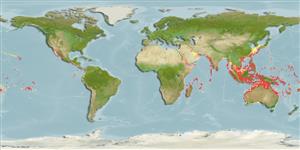分類 / Names
俗名 | 同種異名 | Catalog of Fishes(屬, 種) | ITIS | CoL | WoRMS | Cloffa
Teleostei >
Kurtiformes (Nurseryfishes, cardinalfishes.)
鱸形目 (Nurseryfishes, cardinalfishes.) >
Apogonidae (Cardinalfishes)
天竺鯛科 (Cardinalfishes) > Apogoninae
Etymology: Siphamia: A Swazi word, siphama, for a fish.
More on author: Weber.
Environment: milieu / climate zone / depth range / distribution range
生態學
海洋 礁區魚類; 深度上下限 0 - 100 m (Ref. 90035), usually 1 - 18 m (Ref. 90102). 熱帶
Indo-West Pacific: from the Red Sea south to Madagascar and east through the Maldives, Sri Lanka and India to the Andaman Sea Islands and Western Australia; north to Ryukyus; throughout the Indo-Malayan region to Vanuatu.
中西太平洋: 印尼 (參考文獻 40966) 與東加.(參考文獻 53797)
大小 / 重量 / 年齡
Maturity: Lm ? range ? - ? cm
Max length : 7.0 cm TL 雄魚/尚未辨別雌雄; (Ref. 89972)
背棘 (總數) : 8; 背的軟條 (總數) : 9; 臀棘: 2; 臀鰭軟條: 8. This species is distinguished by the following characters: D1 VII, D2 I,9; A II,8; pectoral fin rays 14-16; tubed lateral-line scales 20-24; median predorsal scales 4 (rarely 3 or 5); total gill rakers 2-4 + 8-10 = 11-14; developed gill rakers 1 + 7-9; gill rakers on ceratobranchial 7-8; body depth 2.3-2.7 in SL and body width 1.9-2.2 in the depth; eye diameter 2.6-3.5 in HL; first dorsal spine 2.4-4.6 in second spine; second dorsal spine 3.7-6.6, second dorsal fin spine 3.7-5.4, second anal spine 5.0-7.0, all in head length; pectoral-fin length 4.2-5.3 and pelvic-fin length 4.2-4.7 in SL; caudal peduncle length 1.5-2.1 in distance between pelvic spine insertion and anal-fin origin; preopercular edge with 23-35 serrations, the preopercular ridge smooth; scales mostly spinoid, but some cycloid scales on anterior part of body; vomer and palatines with 1-2 series of small teeth, but palatines sometimes toothless; tip of light organ on each side of tongue bound by membrane (Ref. 90035).
身體通常全褐色的到黑色的, 但是在將此種與相似的深色一些區分開的背鰭基底之後的二個特殊的白色斑點。 它能很快地改變從黑色到銀白色或者暗色的有黑色的縱向斑紋。 斑紋,當看得見的時候,是可變的被依據棲息地而定的或者寄主, 但是是窄於灰白的間隙.(參考文獻 48635)
Found in coastal reefs and outer reef lagoons. This species forms small groups with long-spined urchins (Ref. 48635) (e.g. Diadema setosum in shallow sheltered waters, Ref. 1602); but was also found among the spines of Acanthaster planci (Ref. 90035). Feeds on zooplanktons and small invertebrates (Ref. 89972).
發現於岸礁與外圍礁石潟湖了。 這種用長棘海膽形成小群魚群。 (參考文獻 48635)
Life cycle and mating behavior
成熟度 | 繁殖 | 產卵場 | 卵 | 孕卵數 | 仔魚
Distinct pairing during courtship and spawning (Ref. 205).中西太平洋: 印尼 (參考文獻 40966) 與東加.(參考文獻 53797)
Gon, O. and G.R. Allen, 2012. Revision of the Indo-Pacific cardinalfish genus Siphamia (Perciformes: Apogonidae). Zootaxa 3294:1-84. (Ref. 90035)
IUCN 瀕危狀態 (Ref. 130435: Version 2024-2)
無危 (LC) ; Date assessed: 05 February 2021
人類使用
工具
特別的報告
下載 XML
網路資源
Estimates based on models
Preferred temperature (Ref.
123201): 24.6 - 29.2, mean 28.3 °C (based on 4132 cells).
Phylogenetic diversity index (Ref.
82804): PD
50 = 0.5000 [Uniqueness, from 0.5 = low to 2.0 = high].
Bayesian length-weight: a=0.01445 (0.00680 - 0.03071), b=3.07 (2.89 - 3.25), in cm total length, based on LWR estimates for this (Sub)family-body shape (Ref.
93245).
營養階層 (Ref.
69278): 3.5 ±0.50 se; based on food items.
回復力 (Ref.
120179): 高度, 族群倍增時間少於 15個月 (Preliminary K or Fecundity.).
Fishing Vulnerability (Ref.
59153): Low vulnerability (10 of 100).
Nutrients (Ref.
124155): Calcium = 184 [87, 344] mg/100g; Iron = 1.21 [0.66, 2.28] mg/100g; Protein = 18.4 [17.1, 19.7] %; Omega3 = 0.146 [0.069, 0.312] g/100g; Selenium = 47.6 [19.5, 104.8] μg/100g; VitaminA = 50.4 [12.9, 206.5] μg/100g; Zinc = 2.15 [1.32, 3.34] mg/100g (wet weight);
